Apr 25, 2024
Apr 25, 2024
The conquest of the North by the marauding forces of Islam had already sounded the death-knell for most of the Hindu empires, with the exception of a few proud Rajput strongholds. The Sultans of Delhi were now in the process of consolidation and administration, and little by little Muslim rule and the Persian-Saracenic way 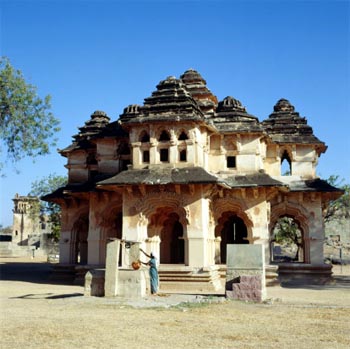 of life began to permeate throughout the land. The south however was largely ignored, with the rulers of Delhi leaving a governor in Daulatabad who nominally ruled in the name of the Sultan but in reality was a law unto himself. Before long, the inevitable happened with these governors revolting and naming themselves the true rulers.
of life began to permeate throughout the land. The south however was largely ignored, with the rulers of Delhi leaving a governor in Daulatabad who nominally ruled in the name of the Sultan but in reality was a law unto himself. Before long, the inevitable happened with these governors revolting and naming themselves the true rulers.
In this melee of changing power, two Hindu princes managed to carve out for themselves a stronghold at Hampi, and established an empire which would be the last great Hindu kingdom before the coming of the British. A million-strong army ensured that the empire continued to grow in size and importance and numerous military successes resulted in Hampi itself being renamed Vijayanagar - the City of Victory.
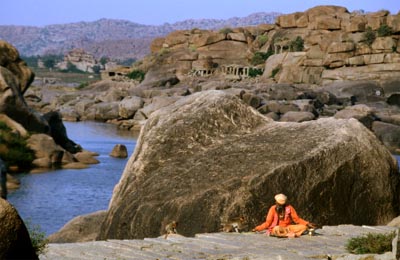 The site of Vijaynagar is spectacular, a city carved out of low lying hills and massive boulders, the treacherous terrain provided ample defense with only a few well-defended accesses. The Tungabhadra river meanders gently through, and at night the boulder-strewn landscape has an almost magical quality.
The site of Vijaynagar is spectacular, a city carved out of low lying hills and massive boulders, the treacherous terrain provided ample defense with only a few well-defended accesses. The Tungabhadra river meanders gently through, and at night the boulder-strewn landscape has an almost magical quality.
Fortifications, outlying fields and a fifteen mile long aqueduct were the defense against a siege. This city has been the subject of many an impassioned travelogue by foreigners - Portuguese and Persians :
"The city of Bidjanagar (Vijayanagar) is such that the pupil of the eye has never seen a place like it and the ear of intelligence has never been informed that there existed anything to equal it in the world. It is built in such a manner that seven citadels and the same number of walls enclose each other… The outer citadel has a fortress, of round shape, built on the summit of a mountain and constructed of stone and lime." *
Living Architecture
The site provided ample raw material for building, and the huge massifs of rock were often themselves sculpted to produce a unique architecture that is part organic, part man-made and often is difficult to distinguish from natural features.
Hampi shows us a change from the normal centralized temple with outlying ancillaries, in the sense that the religious buildings are scattered around in small units, each with its own importance and function, the planning of the whole obeying the diktat of the terrain.
Of the numerous temples and shrines scattered around, we will illustrate two.
The Vithala Temple
The Vithala temple was commissioned by Krishnadeva Raya, the greatest of the Vijayanagar rulers. Its chief peculiarity lies in the extent of its conception (an area of 500 by 300 feet) and the numerous columns, each an orgy of sculpture in itself.
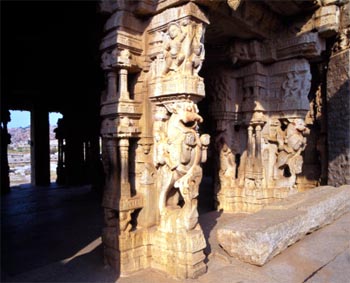 Like a dying gothic monster, the columns rise from massive pedestals and scream upwards into grotesque brackets of enormous proportions. The large space is completely devoured by the forest of columns, and does not have any pretensions to cohesiveness or concept, becoming instead a maze of intricacy, art rather than architecture.
Like a dying gothic monster, the columns rise from massive pedestals and scream upwards into grotesque brackets of enormous proportions. The large space is completely devoured by the forest of columns, and does not have any pretensions to cohesiveness or concept, becoming instead a maze of intricacy, art rather than architecture.
The other major feature in the complex of the same temple is a chariot in granite, whose stone wheels lifted off from the ground are actually capable of revolving around their axles.
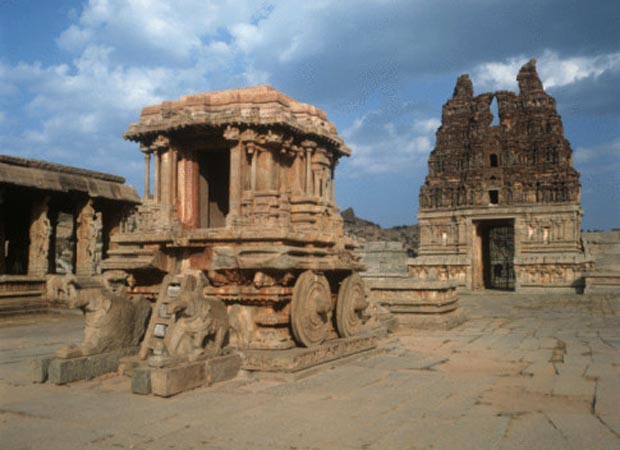
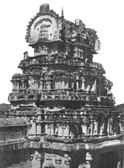 Hazari Ram Temple
Hazari Ram Temple
A private chapel of the same ruler has the same suggestion of the grotesque and the fanciful. A combination of forms, including the Buddhist barrel vaulted roof, adds to the repertoire of shapes.
Civic Architecture and the Influence of Islam
The fascination of Vijayanagar continues with its secular architecture. It is a mix of Hindu and Islamic features, as if the rulers were sufficiently impressed to import craftsmen and master-builders from neighboring Islamic states.
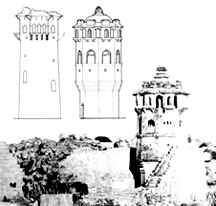 Among the most elegant constructions are the so-called 'watch-towers', although in reality most of them may have been built for pleasure, for the nobility to look out over the city. These towers have elements from both Hindu and Islamic vocabulary with typical Islamic arches, an octagonal or square plan, projecting eaves, corbelled brackets under the windows, and a decidedly Hindu finial.
Among the most elegant constructions are the so-called 'watch-towers', although in reality most of them may have been built for pleasure, for the nobility to look out over the city. These towers have elements from both Hindu and Islamic vocabulary with typical Islamic arches, an octagonal or square plan, projecting eaves, corbelled brackets under the windows, and a decidedly Hindu finial.
The Elephants' Stable, in consonance with the beast's position as an animal for pomp and war, is mighty in conception and is perhaps one of the most impressive buildings in Vijayanagar.
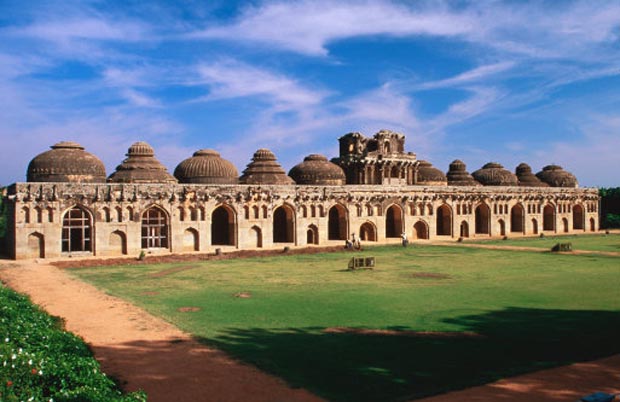
This long, 10-domed structure has mighty arched opening for the animals, very reminiscent of the Lodi tombs in Delhi, and the domes are alternately totally Islamic and with a hint of Hindu influence. The recessed arches in the front elevation as well as the central structure on top (perhaps for drummers and musicians) all combine to make this a must-see.
The beauty of ijayanagar-Hampi, in the ultimate analysis, lies as much in its architecture as in what it represents. For this was the last stronghold of Hindu architecture and art, which were rapidly disappearing in an increasingly Muslim ruled subcontinent. And here too, the influence of Islam was already visible, slowly subsuming Hindu craft in a Hindu kingdom. For this would be the last Hindu fling at monumental architecture. Hindu craftsmen and traditions would continue, would influence the Islamic style, but would never again be paramount.
The twisted sculpture at Hampi, the barren rocky site, the haunting beauty of the landscape by night all contribute to painting for us, as we stand there today, a picture of battles fought, dying elephants and men, charging horses, and finally the eventual sack of the city as it fought vainly to stem the swelling tide of invasion. According to Percy Brown, '..the proud capital was (soon) a forlorn ruin inhabited only by tigers and other wild beasts'.
And as we leave, echoes of the roar of the king of beasts lingers in the still air over proud and deserted ruins of Hampi.
1. From Persian ambassador Abdu’r-Razzaq’s diaries
Black and White Pictures courtesy Michel Polizzi
Read Also: Vijayanagara: The Empire that Vanished! by VK Joshi
All color images under license with Gettyimages.com
26-Aug-2001
More by : Ashish Nangia